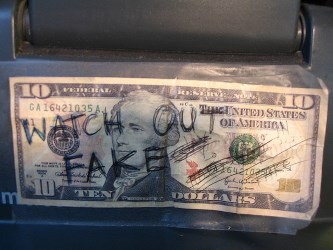COMPELLING TRUTH
Counterfeit Christians
Part 1: Are you one?
By Robin Schumacher

Is it really possible for someone to appear as a true Christian for some time, but really not be born again? Making the question more personal: How can you tell if you're a counterfeit Christian vs. the real thing?
Commanded to Be Sure
Some argue there's really no way for someone to have full assurance that they're truly saved. However, if that's true, why does Scripture command believers to make such an examination to ensure they're in the faith?Paul says, "Test yourselves to see if you are in the faith; examine yourselves! Or do you not recognize this about yourselves, that Jesus Christ is in you—unless indeed you fail the test?" (2 Corinthians 13:5). Following Paul, Peter says, "Therefore, brethren, be all the more diligent to make certain about His calling and choosing you" (2 Peter 1:10).
It would seem strange for a believer to not have any means of ensuring their salvation yet be commanded to perform just such a test. This being the case, Scripture should contain the criteria that believers can use to validate that their faith is real.
Our task, then, is to determine what biblical framework should be used to make such a determination. The great theologian and preacher Jonathan Edwards begins his famous work on this topic by asking for the same thing: "There is no question whatsoever, that is of greater importance to mankind, and what more concerns every individual person to be well resolved in, than this: What are the distinguishing qualifications of those that are in favor with God, and entitled to his eternal rewards?" [1]
Say ‘The Prayer' and You're Done?
Some might say that the only thing needed to ensure a person is truly saved was that they had complied with Romans 10:9 and confessed with their mouth that Jesus was Lord. If they had done that, no other test should be used. When I questioned the individual about the need for a changed life and other certain evidences that the Bible speaks of, the man strongly argued against such things and said I was espousing a works-based salvation.While I appreciate his desire to guard against salvation by works, I believe he was confusing two different things:
- The basis of a person's salvation;
- the evidences that accompany that same salvation.
Did these people that Jesus and James speak of just not articulate the right prayer? Clearly, there seems to be more to the story.
A Recurring Theme
Throughout the New Testament, there is a recurring pattern that Jesus and the apostles lay down for differentiating a true believer from a counterfeit: examine the quality and consistency of fruit that a life displays. Examine the back-and-forth contrasts made in these three example passages that speak to the evidences of who are true believers and who will not experience eternal life with God:"Therefore bear fruits in keeping with repentance.... Indeed the axe is already laid at the root of the trees; so every tree that does not bear good fruit is cut down and thrown into the fire." (Luke 3:8–9)You'll find the same things stated many more times in the gospels. Jesus talks of four soils, only one of which produces fruit (Matthew 13:23); Jesus tells the religious leaders that the kingdom would be taken from them and given to a people who are producing fruit (Matthew 21:43); Christ relays the parable of a fig tree that would be cut down if it didn't produce fruit (Luke 13:6-9); Jesus tells His disciples that He specifically chose them to bear fruit (John 15:16).
"You will know them by their fruits. Grapes are not gathered from thorn bushes nor figs from thistles, are they? So every good tree bears good fruit, but the bad tree bears bad fruit. A good tree cannot produce bad fruit, nor can a bad tree produce good fruit. Every tree that does not bear good fruit is cut down and thrown into the fire. So then, you will know them by their fruits." (Matthew 7:16–20)
"I am the true vine, and My Father is the vinedresser. Every branch in Me that does not bear fruit, He takes away; and every branch that bears fruit, He prunes it so that it may bear more fruit.... As the branch cannot bear fruit of itself unless it abides in the vine, so neither can you unless you abide in Me.... If anyone does not abide in Me, he is thrown away as a branch and dries up; and they gather them, and cast them into the fire and they are burned." (John 15:1–6)
The rest of the New Testament contains similar statements. For example, Paul says we were saved in order to bear fruit for God (Romans 7:4), the writer of Hebrews tells us that good ground that brings forth a useful harvest "receives a blessing from God; but if it yields thorns and thistles, it is worthless and close to being cursed, and it ends up being burned" (Hebrews 6:7–8), and Jude speaks about fake believers who are "autumn trees without fruit, doubly dead, uprooted" (Jude 12).
Time and again, the Bible describes the primary difference between genuine and counterfeit believers being the "fruit" seen in the life of the person. But what exactly is that "fruit", and what does it look like? We'll tackle that question and a few others in Part Two of this series.
[1] Jonathan Edwards, A Treatise Concerning Religious Affections, Kindle Edition, pg 1.
Counterfeit Christians The Series
Part 1: Are you one? How do you know if you're born again?
Part 2: Bearing Fruit: The fruit that we bear shows if we really follow Jesus.
Part 3: U-Turn Christians: Those who leave Christ were never really with Him.
Image Credit: Eric Skiff; "Counterfeit $10"; Creative Commons
comments powered by Disqus
Published 11-22-12

